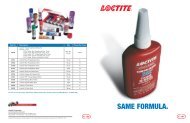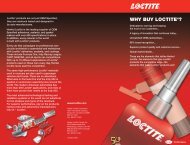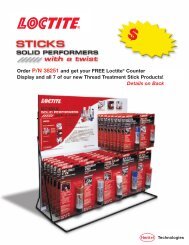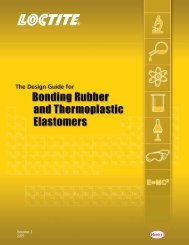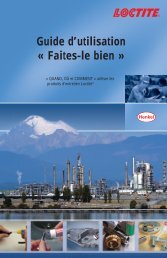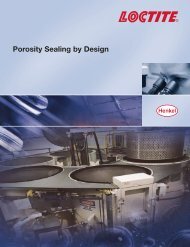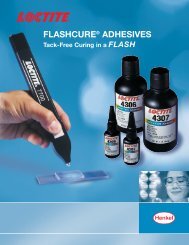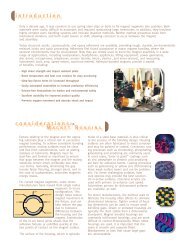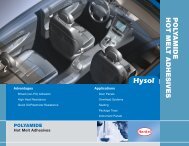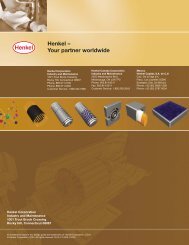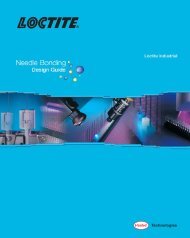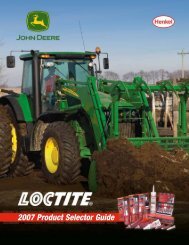Polypropylene (PP)ThermoplasticTrade Names• Adpro• Astryn• Azdel• Endura• Fortilene• HiGlass• Marlex• Moplen• Nortuff• Petrothene• Polyfort FPP• Rexene PP• Tonen• Unipol PP• ValtecManufacturerGenesis PolymersHimont USA, Inc.Azdel, Inc.PPG Industries, Inc.Solvay PolymersHimont USA, Inc.Phillips 66 CompanyHimont USA, Inc.Quantum ChemicalQuantum ChemicalA. Schulman, Inc.RexeneTonen PetrochemShell Chemical CompanyHimont USA, Inc.General DescriptionPP is manufactured by the polymerization of gaseous PP monomer, inthe presence of an organometallic catalyst, at low pressure. The key toPP’s properties is its crystallinity, which is determined by the degreeof organization of the methyl groups on the polymer’s backbone.Syndiotactic PP is formed when the methyl groups alternate aboveand below the plane of the main polymer chain. On the other hand,isotactic PP is formed when the methyl groups all lie above (or below)the plane. Finally, atactic PP results when the methyl groups arerandomly positioned. Specialty grades available include calciumcarbonate, carbon, copper, glass, mica, mineral, and glass bead filled.In 2004, the price of PP ranged approximately from $0.70 to $10.50per pound at truckload quantities.General PropertiesPP is known for its good mechanical properties, heat resistance, andchemical resistance. In addition, PP has the highest flexural modulus ofthe polyolefins, is among the lightest of the engineering thermoplastics(SG=0.90), and has excellent moisture resistance. One of the majordisadvantages of PP is its poor impact strength at low temperatures.However, PP/elastomer blends are available with much improved impactresistance. PP’s mechanical properties are very dependent on its degreeof crystallinity. Isotactic PP is harder, stiffer, and has a higher tensilestrength than atactic PP, while atactic PP exhibits better impact strengthand elongation under stress. Random copolymers are produced byintroducing small amounts of ethylene into the polymerization reactorand result in much improved clarity and toughness at the expense ofstiffness. PP is chemically resistant to most substances includingnonoxidizing inorganics, detergents, low-boiling hydrocarbons, andalcohols. Unfilled PP is flammable and degraded by UV light; however,flame retardant and UV stabilized grades are available.Typical Properties of Polypropylene (PP)American EngineeringProcessing Temperature 390°F to 460°F 199°C to 238°CLinear Mold Shrinkage 0.011 to 0.020 in./in. 0.011 to 0.020 cm/cmMelting Point 320°F to 360°F 160°C to 182°CDensity 56.2 to 56.8 lb./ft. 3 0.90 to 0.91 g/cm 3Tensile Strength, Yield 2.8 to 5.4 lb./in. 2 x 10 3 2.0 to 3.8 kg/cm 2 x 10 2Tensile Strength, Break 2.5 to 5.4 lb./in. 2 x 10 3 1.8 to 3.8 kg/cm 2 x 10 2Elongation, Break 1.8 to 500% 1.8 to 500%Tensile Modulus 1.4 to 2.1 lb./in. 2 x 10 5 1.0 to 1.5 kg/cm 2 x 10 4Flexural Strength, Yield 3.7 to 7.5 lb./in. 2 x 10 3 2.6 to 5.3 kg/cm 2 x 10 2Flexural Modulus 1.1 to 2.5 lb./in. 2 x 10 5 0.8 to 1.8 kg/cm 2 x 10 4Compressive Strength 3.5 to 4.7 lb./in. 2 x 10 3 2.5 to 3.3 kg/cm 2 x 10 2Izod Notched, R.T. 0.3 to 1.0 ft.-lb./in. 1.6 to 5.4 kg cm/cmHardness R65 - R105 Rockwell R65 - R105 RockwellThermal Conductivity 0.8 to 1.6 BTU-in./hr.-ft. 2 -°F 0.12 to 0.23 W/m-°KLinear ThermalExpansionDeflection Temperature@ 264 psiDeflection Temperature@ 66 psiContinuousService Temperature2.1 to 6.5 in./in.-°F x 10 -5 3.8 to 11.7 cm/cm-°C x10 -5SI140°F to 300°F 60°C to 149°C225°F to 310°F 107°C to 154°C200°F to 250°F 90°C to 121°CDielectric Strength 580 to 990 V/10 -3 in. 2.3 to 3.9 V/mm x 10 4Dielectric Constant@ 1 MHzDissipation Factor@ 1 MHzWater Absorption,24 hr.2.1 to 2.7 2.1 to 2.70.0002 to 0.0005 0.0002 to 0.00050.01 to 0.03% 0.01 to 0.03%Typical Applications• Fibers – Carpet backing, diaper coverstock, rope• Packaging – Packaging films, bottles, prescription vials• Appliance – Washer agitators, dishwasher components• Miscellaneous – Straws, luggage, syringes, toys,storage battery cases62The <strong>Loctite</strong> ® Design Guide for Bonding Plastics, <strong>Volume</strong> 4
ADHESIVE SHEAR STRENGTH(psi)(MPa)PolypropyleneUNFILLED RESIN5 rmsROUGHENED26 rmsANTIOXIDANT0.1% Irganox 10100.3% Cyanox STDPUV STABILIZER0.5% Cyasorb UV531IMPACT MODIFIER9% Novalene EPDMFLAME RETARDANT9% PE-684% Antimony OxideSMOKE SUPPRESSANT13% Firebrake ZBLUBRICANT0.1% Calcium Stearate24-26FILLER20% Cimpact 600 TalcProfax 6323 produced by HimontCOLORANT0.1% Watchung RedRT-428-DANTISTATIC0.2% Armostat 475<strong>Loctite</strong> ® 380 Black Max ® Instant Adhesive,Rubber Toughened<strong>Loctite</strong> ® 401 Prism ® Instant Adhesive,Surface InsensitiveMEDICAL: <strong>Loctite</strong> ® 4011 Prism ®Instant Adhesive, Surface Insensitive<strong>Loctite</strong> ® 401 Prism ®<strong>Loctite</strong> ® 770 Prism ® PrimerMEDICAL: <strong>Loctite</strong> ® 4011 Prism ® /<strong>Loctite</strong> ® 7701 Prism ® Primer<strong>Loctite</strong> ® 414 Super Bonder ®Instant Adhesive, General Purpose<strong>Loctite</strong> ® 330 Depend ® Adhesive,Two-Part No-Mix Acrylic<strong>Loctite</strong> ® 3105 Light Cure Adhesive,MEDICAL: <strong>Loctite</strong> ® 3311 Light Cure Adhesive<strong>Loctite</strong> ® 3340 Light Cure Adhesive,UV Cationic Epoxy<strong>Loctite</strong> ® 4305 Flashcure ® Light Cure AdhesiveFLUORESCENT: <strong>Loctite</strong> ® 4307 Flashcure ®Light Cure Adhesive<strong>Loctite</strong> ® H3000 Speedbonder Structural Adhesive, General Purpose<strong>Loctite</strong> ® H4500 Speedbonder Structural Adhesive, Metal Bonder<strong>Loctite</strong> ® 3030 Adhesive, Polyolefin Bonder<strong>Loctite</strong> ® E-00CL Hysol ® Epoxy Adhesive,Low Odor<strong>Loctite</strong> ® E-90FL Hysol ® Epoxy Adhesive,Flexible<strong>Loctite</strong> ® E-30CL Hysol ® Epoxy Adhesive,Glass BonderMEDICAL: <strong>Loctite</strong> ® M-31CL Hysol ®Epoxy Adhesive, Glass Bonder<strong>Loctite</strong> ® E-20HP Hysol ® Epoxy Adhesive,Fast SettingMEDICAL: <strong>Loctite</strong> ® M-21HP Hysol ®Epoxy Adhesive, Fast Setting<strong>Loctite</strong> ® E-214HP Hysol ® Epoxy Adhesive,High Strength<strong>Loctite</strong> ® Fixmaster ® High Performance Epoxy<strong>Loctite</strong> ® 1942 Hysol ® Hot Melt Adhesive,EVA Based<strong>Loctite</strong> ® 3651 Hysol ® Hot Melt Adhesive,Polyolefin<strong>Loctite</strong> ® 7804 Hysol ® Hot Melt Adhesive<strong>Loctite</strong> ® 3631 Hysol ® Hot Melt Adhesive,Urethane<strong>Loctite</strong> ® U-05FL Hysol ® Urethane Adhesive,High Strength<strong>Loctite</strong> ® Fixmaster ® Rapid Rubber RepairOEM: <strong>Loctite</strong> ® U-04FL Hysol ®Urethane Adhesive, Fast Setting<strong>Loctite</strong> ® 5900 ® Flange Sealant,Heavy Body RTV Silicone500.3500.3500.3195013.5>1950 † 1300>13.5 † 9.0500.32001.41000.71000.72001.41950 † >1950 † >1950 † >1950 †>13.5 † >13.5 † >13.5 † >13.5 † >13.5 † >13.5 † >13.5 † >13.5 † >13.5 †500.32001.41000.7500.32001.41000.72001.42001.41000.7500.32001.42501.7500.32001.41000.7500.3500.3500.32001.41000.7500.3500.31000.72001.41000.7500.3500.3500.32001.41000.7Adhesive Performance<strong>Loctite</strong> ® 401 Prism ® Instant Adhesive, used in conjunction with <strong>Loctite</strong> ® 770 Prism ® Primer, achievedthe highest bond strengths on PP, typically substrate failure. <strong>Loctite</strong> ® 3030 Adhesive (a polyolefinbonding adhesive) achieved comparable strength but no substrate failure. <strong>Loctite</strong> ® 3651 Hysol ® HotMelt Adhesive (polyolefin based) had the third highest strength. All others adhesives tested performedpoorly on unprimed, un-abraded PP.Surface TreatmentsThe use of <strong>Loctite</strong> ® 770 Prism ® Primer, in conjunction with <strong>Loctite</strong> ® 401 Prism ® Instant Adhesive, or500.32001.42001.42001.41000.7<strong>Loctite</strong> ® 4011 Prism ® Medical Device Instant Adhesive with <strong>Loctite</strong> ® 7701 Prism ® Primer, resulted in adramatic, statistically significant increase in the bond strengths achieved on PP, typically substrate failure.Surface roughening resulted in either no effect or a statistically significant increase in the bond strengthsachieved on PP.Other Important Information• Polypropylene is compatible with all <strong>Loctite</strong> ® brand adhesives,sealants, primers, and activators.• Surface cleaners: isopropyl alcohol, <strong>Loctite</strong> ® ODC-Free Cleaner & Degreaser.NOTES:† Due to the severe deformation of the block shearspecimens, testing was stopped before the actual bondstrength achieved by the adhesive could be determined(the adhesive bond never failed).The addition of the indicated additive (or surfaceroughening) caused a statistically significant decrease inthe bond strength within 95% confidence limits.The addition of the indicated additive (or surfaceroughening) caused a statistically significant increase inthe bond strength within 95% confidence limits.The <strong>Loctite</strong> ® Design Guide for Bonding Plastics, <strong>Volume</strong> 4 63



